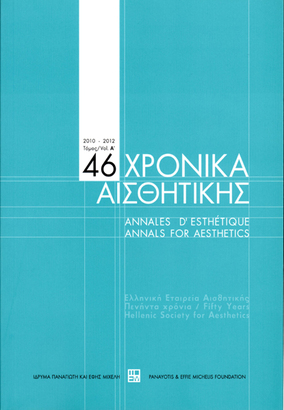Παρατηρήσεις στη θρησκευτική τέχνη των Επτανήσων
Part of : Χρονικά αισθητικής : ετήσιον δελτίον της Ελληνικής Εταιρείας Αισθητικής ; Vol.27-28, No.1, 1988, pages 43-61
Issue:
Pages:
43-61
Parallel Title:
Comments on the religious art of the Ionian islands
Author:
Abstract:
It is common knowledge that, whereas the Eastern Orthodox Church accepts only two-dimensional representation of holy persons and, in certain cases, bas-reliefs, the Western Church, in addition to these, accepts three-dimensional as well, in other words, statuary in religious works of art.It is also known that dogmatic confrontation between the two Churches developed sharply during the middle and later ages and that considerable influence from the Western Church came as far as Greek territories but, nevertheless, failed to alter the basic dogmatic principles and corresponding works of art of the Eastern Church.This text examines the results of this clash in the Ionian Islands, a particularly sensitive area due to its geographical position, which for at least seven centuries remained under continuous Western rule, mainly Venetian without, however, any change or decline in the adherence of the inhabitants to Orthodoxy.Western influence in religious painting, both in that of Crete and of the Ionian Islands, is well known and relative studies have already provided us with much data concerning it. The present study pinpoints influence of another nature, again concerning paintings which, although formally at least remaining two-dimensional, are so arranged as to impart into the spectator the sense of a third dimension. The body of the Crucifix, for example, which now assumes a clearly plastic form and rests upon the Cross, exceeding its outline, the perforated decorations which frame the bodies of the Saints in certain cases or finally, the setting of the complete bodies of Saints whose images have been cut along their outlines and are shown in front of a plane or a shallow semi-circular depth, certainly constitute the maximum concession in Eastern ikon painting under the pressure of Western influence.It is probably to the same influence that certain bas-reliefs or statuary of small size, more of a decorative nature to wood carvings, are due while in silversmith’s works of art the influence is still stronger
Subject:
Subject (LC):
Notes:
Αποτελεί ανακοίνωση στο Ε' Διεθνές Πανιόνιο Συνέδριο, Αργοστόλι, Κεφαλλονιά, Μάϊος 1986, Περιέχει εικόνες




